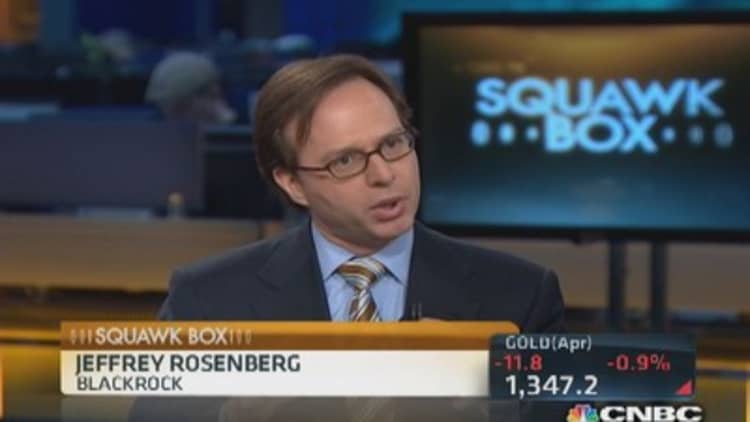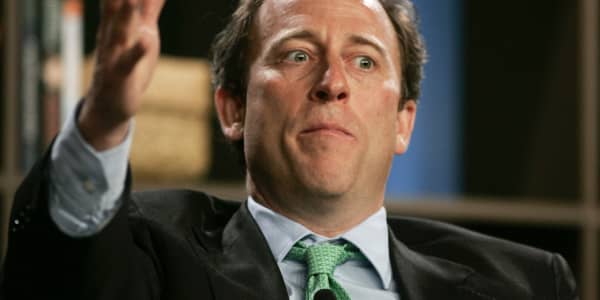It seems bond investors are no better at predicting market direction than their stock-picking counterparts.
Anticipating a sudden spike in interest rates, investors began dumping their fixed-income funds last year after the U.S. Federal Reserve announced it would begin tapering its economic stimulus program this January. But so far, at least, rates remain near record lows.
Now investors are rotating back to the safety of bonds amid the recent uptick in equity-market volatility, mirroring the herd mentality that more often defines active stock traders.
Year-to-date net inflows to all bond funds through March 7 reached $19.9 billion, in stark contrast to the $91.3 billion that flowed out of bond funds in 2013, according to fund-tracking firm EPFR Global. Sentiment was vastly different still in 2012, when net inflows to bond funds reached a record $493.6 billion.
"Over the past two to three years, professional and individual investors alike have not been great about guessing the direction of interest rates," said Christine Benz, director of personal finance at research firm Morningstar.
The smart money was on rising rates in 2012, she noted, as bond investors prematurely flocked to shorter-duration securities.
"Even what seemed to be a clear direction for fixed income didn't necessarily play out the way people thought it might," Benz said.
Read MoreDealing with rising rates, step by step
Interest rates and bond prices generally move in opposite directions: When interest rates rise, bond prices fall — and vice-versa. Thus, bonds lose value in a rising interest-rate environment.
Those who read the economic tea leaves agree that interest rates will trend slowly higher in the coming year.
Panic doesn't pay
How fast and how far remain to be seen, but Federal Reserve Chair, suggesting rate hikes could begin six months after the U.S. central bank ends its aggressive bond-buying program this fall. That means rate increases may kick in as early as spring of 2015.
Bob Doll, chief equity strategist at Nuveen Asset Management, predicts the benchmark 10-year Treasury yield will move toward 3.5 percent this year from its current yield of roughly 2.8 percent as the Fed completes tapering and holds short-term rates near zero. The 2014 economic outlook by Wells Fargo forecasts that the 10-year Treasury will stand at 3.2 percent.
Amid the uncertainty of interest-rate risk and the hit-or-miss history of market-timing techniques, the message for average investors is clear: Panic doesn't pay.
"Message No. 1 for investors is: Don't panic," said Nicholas Colas, chief market strategist for brokerage firm ConvergEx Group, adding that "contrary to the narrative that said interest rates would instantly rise when the Fed taper started and spooked a lot of investors last year by saying that bonds were not the place to be, the bond market has been up."
Read MoreSky-high rates from days gone by
"You'll hear a lot about the improving economy causing higher inflation, but the bottom line is that bonds will be a perfectly fine place to be in 2014," Colas added.
The vast majority of investors are best served by creating a diversified portfolio based on their age and risk profile and holding firm no matter which way the economic winds blow, Colas said.
That goes double for retirees and soon-to-be retirees who can ill afford to repeat their mistakes of the past. Indeed, many investors reacted with costly knee-jerk adjustments to their asset allocation during the stomach-churning downturns in 2001 and 2007–08.

"That was OK, because most were still working and had the opportunity to put more money back into their retirement funds, but as the population ages, they can't afford to make those mistakes anymore," Colas said.
Morningstar studies repeatedly show that most investors negatively impact their long-term return by buying in too late (when a fund is ready to cool off) and selling when its performance is poised to pick up.
The typical investor, the firm has found, gained 4.8 percent for the 10 years ended December 2013 versus 7.3 percent for the typical fund — a gap attributed primarily to bad calls.
Read MoreAre bonds still a safe bet?
Most investors tend to select good funds, according to Morningstar's findings. But their timing in moving among asset classes is poor.
For that reason, Greg Ghodsi, senior vice president of investments at Raymond James, said bonds can best be described as the unsung heroes of a well-balanced portfolio.
In addition to the income and stability they provide, he said, exposure to fixed-income yields an important psychological benefit, enabling skittish investors to stay the course in the face of market downturns.
"Bond funds reduce the overall volatility of your portfolio, and we feel that's very important because it allows you to take risk on the equity side," Ghodsi said. "Having that cash flow coming in to take care of expenses allows you to maintain a longer-term perspective on stocks and hopefully grow your entire net worth over time."
Get tactical
The ability to tune out all the noise is increasingly important in the modern-day market, added Colas of ConvergEx Group.
"One of the hallmarks of 2014 is that we're going to see a lot more volatility in stocks than we have in the past three years," he said. "The equity market should still deliver 7 percent to 9 percent returns on an annual basis, but you're going to have to work much harder for those returns than you once did. That's why having a good anchor in your bond portfolio is so important."
That's not to say that buy-and-hold investors can't minimize interest-rate risk by being tactical with their future bond purchases.
Longer-term bonds are generally more volatile, or sensitive to interest-rate fluctuations, while shorter-duration bonds, including Treasuries with a maturity of three to seven years, are less sensitive to rising rates than the 30-year bond, or even the benchmark 10-year Treasury.
Read MoreAre ETFs the fund world's Amazon.com?
Given the return of economic stability and the rising rate environment, Colas suggests that bond investors in the market to buy should focus on high-quality corporate bonds, tax-exempt municipal bonds and shorter-duration Treasurys.
"In many ways, investment-grade corporate bonds are safer than most government bonds," he said. "U.S. corporations, in particular, are in such a good position from a balance-sheet standpoint and in most cases are generating record profits.
"These are well-run companies that have come through the fire in the past couple of years and emerged extremely strong," he said.
Be forewarned, however, that shorter-duration bonds pay less than long-term bonds. As such, income investors may need to tweak their equity allocation to cover their cash-flow needs, said Ghodsi at Raymond James.
"Five-year bonds produce much lower income than 30-year bonds, so you have to look at your allocation in the scope of your entire portfolio to be sure you're getting the income you need," he said.
Start by determining how much cash you need to generate annually and work your way backward, Ghodsi suggested. Those who find their bond portfolio is not kicking off enough, he added, might consider increasing their allocation to stocks that pay a consistent dividend.
Read MoreInvesting tips to deal with rising rates
Morningstar's Benz also suggested income investors (particularly retirees) perform a portfolio stress test to assess their level of interest-rate risk so they're not caught holding the bag when rates begin to climb.
For every 1 percentage point increase in Treasury yields, she said, investors can expect to lose an amount equal to their fund's duration.
For example, if a fund has a duration of 4.0, a 1 percent increase in Treasury yields would result in a 4 percent drop in the fund.
Stay diversified and mind your time horizon when thinking about what types of assets to hold.Christine Benzdirector of personal finance, Morningstar
"Stay diversified and mind your time horizon when thinking about what types of assets to hold," said Benz, noting this is not the time for overly specialized bond funds that invest primarily in a single sector, industry or geographic region.
"Core flexible bond funds make a lot of sense, since the fund manager can actively adjust their portfolio as needed and invest in foreign bonds, emerging market funds or venture far and wide among different types of aggressive fixed-income investments."
Her top core bond-fund picks: Pimco Total Return or Dodge and Cox Income. Benz also recommended Loomis Sayles Bond Fund as an "aggressive kicker."
Read MoreInflation risk low, investors shun TIPS
The merits of buy-and-hold investing apply not just to equities but to bond funds as well. Investors who stick to the plan, stay diversified and tune out all the noise from Washington will fare far better than those who try to time the market, if history is any guide.
In the meantime, you might want to invest in some earplugs.




